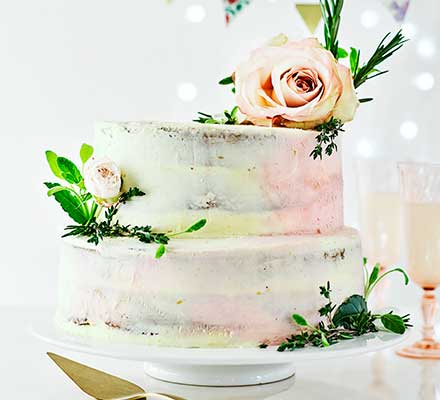Easiest ever wedding cake
Take the stress out of the big day with a wedding cake that bakes all at once from one easy mix. You can choose the decoration to suit your taste
-
Prep:20 mins
Cook:1 hrs
- Serves 70
- Easy
Nutrition per serving
-
kcal 282
-
fat 14g
-
saturates 7g
-
carbs 36g
-
sugars 27g
-
fibre 1g
-
protein 3g
-
salt 0.4g
Ingredients
- 12 large eggs
- 750g self-raising flour
- 750g golden caster sugar
- 200ml vegetable oil
- 350g butter, softened, plus extra for the tins
- 3 tsp baking powder
- 3 lemons, zested
- 500g butter, softened
- 1kg icing sugar
- 3 tbsp milk
- 2 lemons, zested
- 2 lemons, juiced
- 300g lemon curd
- 25cm round springform cake tin
- 20cm round springform cake tin
- cake boards
- 6 plastic drinking straws
Tip
Wedding cake tips? Ovens do vary, so you may find the larger cake takes longer. If so, cover with foil after 1 hr and check again every 10 mins.
? Make sure the wedding catering staff are aware that there are straws inside the cake before they serve it.
? Only ever use edible flowers and plants to decorate.
Method
Line the cake tins with baking parchment and butter the bases and sides well. Heat oven to 190C/170C fan/gas 5. Combine all the cake ingredients in a freestanding mixer until smooth and pale, starting at a low speed as the bowl will be very full; or use an electric handwhisk and a large bowl, if you prefer.
Set the 25cm cake tin on scales and pour in 1.5kg batter. Do the same with the 20cm tin and pour in the rest (it should be about 1kg).
Bake the cakes in the oven for 1 hr or until risen, golden and a skewer inserted into the middle of the cake comes out clean (see tip). Cool the cakes in their tins for 10 mins, then turn out onto wire racks to cool completely. Can be made ahead and frozen.
To make the buttercream, cut the butter into pieces, add about 1/3 of the icing sugar and beat well with an electric handwhisk. Once fully combined, add the next 1/3 and beat again. Repeat once more with the remaining sugar, the milk and lemon zest, and keep beating until pale. For the filling, stir the lemon juice and curd together in another bowl and set aside until needed.
To assemble the cake, trim the tops and cut both cooled sponges in half horizontally using a serrated knife. Spread just over half the filling on top of one of the larger sponges and the rest over a smaller one. Leave for 5 mins. Spread 250g buttercream over the filling on the larger sponge and sandwich the other larger sponge on top. Do the same with the smaller sponges, using 150g buttercream.
Stick your cakes onto cake boards using a small blob of buttercream under each. Spread some of the remaining buttercream all over the tops and sides of both cakes in a really thin layer – this will bind with loose crumbs to create an undercoat for your chosen decoration. Put both cakes in the fridge for 1 hr to firm up.
To stack the cakes, push a straw down into the centre of the larger cake. Snip the top off with scissors so that it’s flush with the buttercream layer. Add five more straws around the central one, equally spaced apart. Carefully place the smaller cake on top, then spread the rest of the buttercream all over the surface to cover it or fill in any gaps. Design 1: Floral (keeps for 2-3 days)? Dye 200g of your buttercream the colour of your choice using a few drops of food colouring.? Fill and cover the cake with the remaining buttercream.? Add a few daubs of the coloured buttercream on one side and blend it with the base colour using a cake scraper.? Go round the cake a few times with the cake scraper to create a rustic but smooth finish.? Decorate with edible flowers such as organic roses, and fresh herbs like rosemary, bay and thyme.Design 2: Ruffles(keeps for 3-4 days)? Roll 700g white fondant icing out on a surface dusted with icing sugar. Drape over the largest cake after the buttercream has chilled, but before stacking. Smooth it over, then trim off the excess.? Do the same with 400g white fondant icing for the top layer, then stack the cakes.? Take a block of 600g white fondant icing and pinch off pieces each about the size of a large strawberry. Roll into thin, wide strips (it’s preferable to end up with a mixture of lengths), then use a sharp knife to cut them lengthways to create two pieces.? Make a thin paste using icing sugar and water, then spread a little along the flat edges of the strips.? Stick them to the sides of the cake, starting at the bottom and working up. Bend the fondant to create pleats and waves. Overlap from the bottom up until all the sides are covered.? Decorate with a cake topper if you like.Design 3: Polka dot (keeps for 3-4 days)? Roll 700g pink sugar paste out on a surface dusted with icing sugar. Drape over the largest cake after the buttercream has chilled, but before stacking. Smooth it over, then trim off the excess.? Do the same with 450g of white fondant icing for the top layer.? Make a thick paste using icing sugar and water, and use it to stick on white chocolate buttons and white chocolate jazzies onto the larger cake to create a polka dot effect.? Push 2-3 tbsp edible silver balls into the smaller layer’s icing, then stack the cakes.? Add a cake topper and a ribbon, if you like.





















